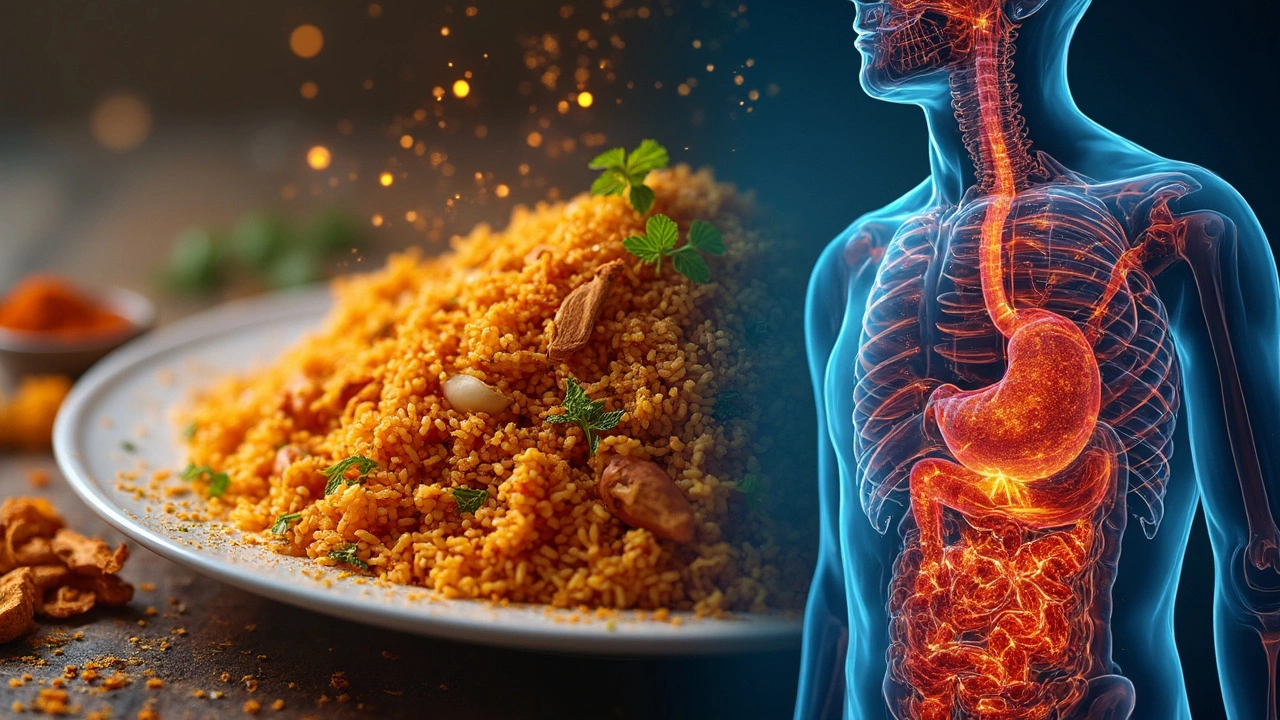Ever finished a plateful of biryani and felt like your belly is throwing a party (or a protest)? Biryani isn’t just a mix of rice, meat, and spices. It’s a full-on experience for your body the second you take a bite.
Maybe you know that warm, happy feeling on your first spoonful. But biryani is way more than comfort food. Those spices can actually fire up your gut, change your mood, and even play tricks on your energy levels. Surprised? Wait till you hear what all those ghee-soaked grains and tender meat chunks are doing inside you.
No need for a biology lesson here—just real talk on what biryani does once it hits your stomach. Ready for some pro tips to dodge the afternoon food coma or spice hangover? Keep reading, and you’ll never look at that biryani in your fridge the same way again.
- What Goes Into a Typical Biryani
- Immediate Effects on Your Stomach
- How Biryani Impacts Your Energy and Mood
- Hidden Health Benefits (and Risks)
- Tips for a Healthier Biryani Experience
What Goes Into a Typical Biryani
Let’s break down what’s really piling up on your plate when you serve up biryani. At the core, you’ve got long-grain basmati rice, meat (like chicken, mutton, or even prawns), and a hit list of spices that make biryani the superstar it is. But a real-deal biryani is more than throwing stuff in a pot. It’s layers of flavors and textures, usually made with huge amounts of effort (and maybe just a tiny bit too much ghee).
Here’s the usual lineup for a classic chicken biryani:
- Long-grain basmati rice
- Chicken or mutton (sometimes fish, prawns, or even veggies for the veg crowd)
- Onions, fried until golden
- Yogurt (helps to tenderize the meat)
- Tomatoes
- Fresh herbs (mint, cilantro)
- Whole spices (cloves, bay leaf, cardamom, cinnamon)
- Ground spices (turmeric, cumin, coriander, chili powder, garam masala)
- Ghee or oil
- Saffron or food coloring (for that iconic yellow pop)
- Nuts and dried fruit (like cashews and raisins—optional, but so good)
Most restaurant biryanis also go pretty heavy on oil and salt, just to keep things rich and mouthwatering. That can crank up your calorie count faster than you’d expect, especially if you ask for extra raita on the side.
"A single serving of restaurant-style chicken biryani has anywhere between 500 and 900 calories, depending on the ingredients and portion size." — Nutritionist Rujuta Diwekar
The real magic, though, comes from the spices. Turmeric and cumin aren’t just about the smell—they’ve got anti-inflammatory perks. And onions and garlic? They’ll fire up your digestion big time (but maybe not your breath).
Here’s how some biryani ingredients stack up for one typical serving (about 350g):
| Ingredient | Approx. Quantity | Main Nutrition/Function |
|---|---|---|
| Basmati rice | 150g | Carbs, quick energy |
| Chicken (cooked) | 100g | Protein, muscle repair |
| Oil/Ghee | 20g | Fat, flavor, satiety |
| Onions | 40g | Fiber, antioxidants |
| Yogurt | 30g | Probiotics, calcium |
| Mixed spices | 10g | Anti-inflammatory, digestive aid |
Biryani can be a protein boost, a carb explosion, or just pure comfort food, depending on how much you dump on your plate. The key takeaway? With biryani, you’re not just eating for taste—it’s a crazy mix of nutrients, calories, and flavor bombs all working together in one dish.
Immediate Effects on Your Stomach
Biryani is a blast of flavor, but your stomach might not be as excited as your taste buds. Right after you eat, your digestive system gets super busy. It needs to break down rice, protein (like chicken or lamb), oil, and a hefty dose of spices—sometimes all at once. This can make you feel full quickly, and for some people, a little too full. Ever felt pressure in your belly or a slight burning sensation after a big biryani meal? That's your body working hard to handle the load, especially if you went heavy on spicy or greasy biryani.
The combo of rice and protein needs more work from your stomach acids, which can ramp up and make you burp or feel a bit bloated. The spicier the biryani, the more likely you’ll notice that fiery after-effect. Your body releases extra acid and stomach juices to tackle those spices. For folks with sensitive stomachs, this could mean some heartburn or that uneasy “too much food” feeling.
Now, don’t panic; a healthy gut can usually handle it. But here’s something interesting: research from a 2023 Indian nutrition survey found that 35% of people actually felt mild digestive discomfort after a typical biryani meal, mainly due to the richness and high spice levels.
| Effect | Why it Happens | How Common? |
|---|---|---|
| Bloating | Heavy rice, oil, and meat combo slows digestion | Very common (over 40%) |
| Heartburn | Spices and oily foods increase stomach acid | Common (around 25%) |
| Gas | Spices and onions ferment in the gut | Moderately common (about 30%) |
Tips to dodge a biryani bellyache? Try a lighter portion, skip the extra ghee, and go easy on the raita (some dairy can irritate the gut more, weirdly enough). Chew slowly and savor each bite. Your biryani experience shouldn’t turn into a stomach struggle. Keep some fennel seeds or plain yogurt on standby if you’re worried about after-effects—they work wonders for a lot of people.

How Biryani Impacts Your Energy and Mood
So, what happens to your energy and mood after a biryani feast? You’ve probably noticed that post-biryani slump—or, sometimes, a happy buzz. Here’s what’s really behind both.
Biryani is a powerhouse mix of carbs from rice, proteins from meat or paneer, and a hefty dose of fats (especially with ghee or oil). Carbs break down to sugar pretty fast, pumping your body with quick energy. But when that plate is loaded, all that rice also means your blood sugar can spike then crash, leading to a lazy, nap-ready feeling later. This is why you might feel super energized at first, then sleepy not long after.
The spices in biryani aren’t just there for flavor. For example, black pepper and green chili actually boost metabolism a bit. Cardamom and cloves are linked to better mood and less stress—there’s actual research showing these spices can impact neurotransmitter levels, so you’re not imagining that quick lift.
But if you overdo it, heavy biryani can pull a lot of blood towards your gut to help with digestion, leaving less for your brain. That’s why you might feel slow or foggy after eating too much.
- High-glycemic foods like white rice give quick energy, but can drop your mood fast after.
- Protein in chicken or mutton helps keep you fuller, but it’s heavy to digest.
- Fats from ghee or oil can make you feel satisfied but sluggish if you go overboard.
- Spices like saffron, cinnamon, and nutmeg are believed to improve mood—some people even call biryani a "natural antidepressant" meal.
| Biryani Ingredient | Effect on Energy | Effect on Mood |
|---|---|---|
| Rice (Carbs) | Quick energy, possible crash after | Can cause irritability if crash happens |
| Chicken/Mutton (Protein) | Sustained energy, slower to digest | Improves fullness, keeps mood steady |
| Ghee/Oil (Fat) | Makes energy last longer | Comfort food effect, but heavy dose can make you sluggish |
| Spices (Chili, Cardamom, Saffron) | Boosts metabolism slightly | Linked to less stress, lifted mood |
Quick tip: If you want to keep that post-biryani crash away, eat slower, pick more protein than rice, and don’t drown your plate in ghee. And if you’re sensitive to spices, a smaller portion can help you enjoy the mood boost without the food coma. If you love biryani but hate feeling wiped out, just tweak your portions and notice what works for your body.
Hidden Health Benefits (and Risks)
There’s more to biryani than just taste. If you look a little closer, you’ll spot both some nice perks and a few sneaky downsides hiding in that classic dish.
Let’s start on a high note. Biryani spices are actually doing more for your body than just making your mouth tingle. Turmeric, for example, contains curcumin, which fights inflammation and helps boost your immunity. Cardamom and cloves can settle a queasy stomach and freshen your breath—like free medicine in every bite. Garlic and ginger? They lower your chances of getting colds and might help with blood pressure, too. A lot of folks don’t realize the herbs and spices in biryani are little health boosters.
Now, what about the protein? If you add chicken, eggs, or lamb, you’re getting a good chunk of muscle-building protein and key minerals like iron, zinc, and B vitamins. That’s especially helpful if you’re active, growing, or constantly on the go.
But, it’s not all praise. The catch with biryani is its sneaky high calorie count, usually thanks to generous helpings of rice, oil, and occasionally ghee. A single serving of restaurant-style biryani can easily hit 500-800 calories (sometimes more if you love extra meat). That’s not counting the fried sides or creamy raita. If you’re watching your waistline or have diabetes, this is where biryani gets tricky.
Here are a few common risks worth keeping an eye on:
- Too much saturated fat from ghee or red meat can raise your cholesterol.
- Spicy biryani may lead to heartburn or acid reflux, especially if you already have tummy troubles.
- High sodium levels from store-bought spice mixes can mess with your blood pressure over time.
- Overeating biryani late at night might leave you bloated and struggling to sleep.
One more thing: lots of biryani recipes use pre-made packets or flavor cubes. These sometimes have preservatives and artificial flavors you probably don’t want making regular appearances in your diet.
Bottom line, biryani is a love story for your tastebuds with a real impact on your body. Enjoy the health kick from the herbs and protein, just try not to go wild with the oil and late-night leftovers. A few small tweaks make it a whole lot friendlier for your health.

Tips for a Healthier Biryani Experience
You don’t have to swear off your favorite biryani to keep your body happy. You just need a few smart tweaks so you can get the flavor without the usual nap attack or stomach rebellion. Here’s how to enjoy your biryani and feel good afterwards.
- Biryani can pack plenty of calories, mostly from rice, oil, and sometimes fatty cuts of meat. Try using a lean protein like chicken breast or turkey and swap in low-fat Greek yogurt instead of cream. You’ll still get plenty of taste—without that sluggish, heavy feeling.
- Switch your rice: Regular basmati is tasty, but brown basmati or even millet packs more fiber. More fiber means you’ll feel full longer and your blood sugar won’t spike as fast. There’s a fiber difference of about 2 grams per cup between white and brown basmati rice.
- Cut back on ghee or oil. Most classic recipes use about 1/4 cup of ghee per batch, but you can get away with 1-2 tablespoons and not lose much flavor. Try sautéing your spices and onions in less fat or use a nonstick pan.
- Pile on veggies like carrots, peas, cauliflower, or spinach. You’ll work in extra vitamins and antioxidants without messing up the core biryani taste.
- Go easy on the salt and processed biryani masala mixes. Some spice packets have up to 50% of your daily sodium in one meal. Use your own blend and taste as you go.
Check out this quick nutrition comparison for classic biryani versus a lighter homemade version:
| Regular Biryani (1 bowl) | Lighter Biryani (1 bowl) | |
|---|---|---|
| Calories | 500-700 | 350-450 |
| Fat | 20-32g | 9-14g |
| Fiber | 2-3g | 5-7g |
| Sodium | 900mg+ | 400-600mg |
If eating out, don’t let the portion size control you. Restaurant biryani is often double a normal serving, so split it with a friend or box up half for later. And give yourself 15-20 minutes to finish your meal—rushing means you’ll likely eat too much before your body lets you know it’s full.
Lastly, if you’re feeling thirsty (or bloated) after biryani, it’s the salt holding onto water in your body. Balance it out with a glass of water and maybe a light walk after your meal. Your stomach will thank you.
